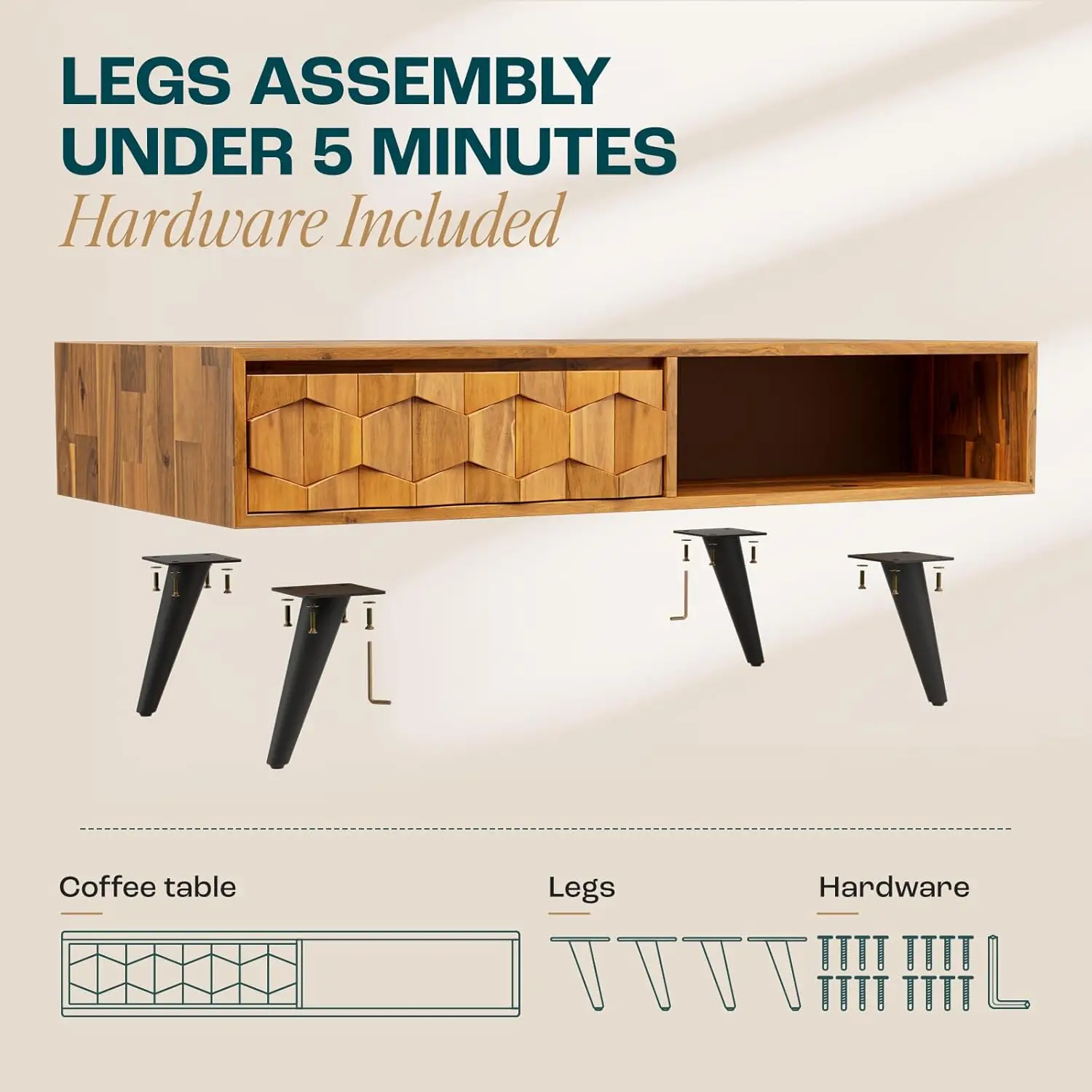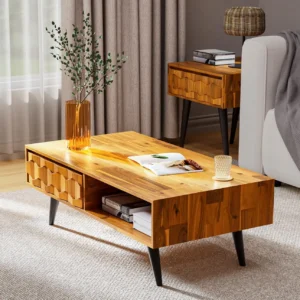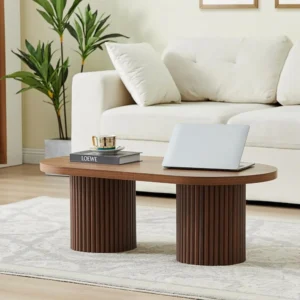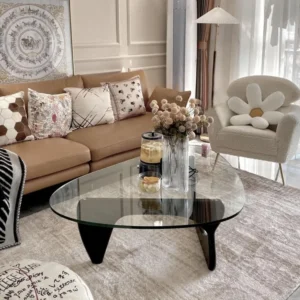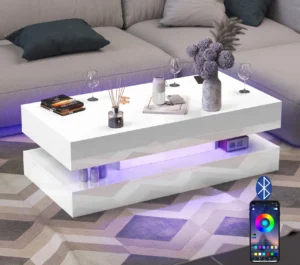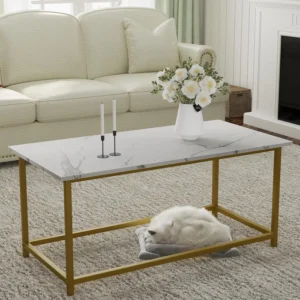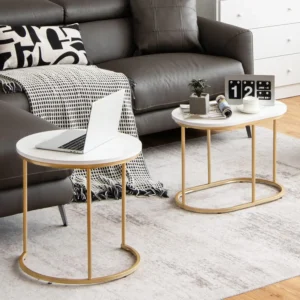The Enduring Appeal of Classic Teak Coffee Tables
A classic teak coffee table is more than just a piece of furniture—it’s a timeless design statement characterized by clean lines, balanced proportions, and exceptional craftsmanship. These enduring pieces have maintained their popularity across generations because they masterfully blend form and function in a way that transcends passing trends.
Teak wood stands apart from other furniture materials due to its remarkable natural properties. The wood contains natural oils that make it exceptionally resistant to moisture, insects, and decay—qualities that contribute to its remarkable longevity. Its warm honey color develops a beautiful silvery-gray patina over time, telling a visual story of the piece’s history.
Historically, teak became prominent in furniture design during the mid-20th century when designers sought materials that could embody their philosophy of accessible, functional beauty. The wood’s strength and stability made it perfect for the clean lines and organic forms that defined the era’s most innovative furniture.
Throughout this guide, we’ll help you identify, appreciate, and care for classic teak coffee tables by exploring their defining features. Understanding the hallmarks of classic black mid-century coffee tables provides valuable context for appreciating how teak versions evolved within this influential design movement.
For many discerning homeowners, a piece from our collection of mid-century modern teak coffee tables represents functional art at its finest—objects that not only serve a practical purpose but also bring authentic design history into everyday living spaces.
Mid-Century Modern and Scandinavian Influence: The Golden Era of Teak
The Mid-Century Modern Revolution
The period roughly spanning 1945 to 1975 gave birth to Mid-Century Modern design, a movement that forever changed how we think about furniture. This design philosophy celebrated clean lines, gentle organic curves, and a seamless flow between indoor and outdoor spaces. Designers of this era rejected ornate details in favor of simple, honest forms that highlighted the natural beauty of materials.
Teak became the signature wood of this movement because its warmth and character perfectly balanced the sometimes stark minimalism of modern design. The rich grain patterns and honey tones brought natural elements into homes increasingly filled with new manufacturing materials like plastics, fiberglass, and metals.
Many iconic black mid-century coffee table styles that originally appeared in darker woods were reinterpreted in teak, showcasing the versatility of mid-century design principles across different materials.
Scandinavian Design Philosophy
While Mid-Century Modern flourished internationally, Scandinavian design—particularly from Denmark—elevated teak furniture to an art form. The Nordic approach embraced functionality, minimalism, and natural materials as core principles, making teak a perfect fit for their aesthetic.
Scandinavian designers believed beautiful, well-made furniture should be accessible to everyone, not just the wealthy. This democratic design philosophy led to furniture that was elegant yet unpretentious, sophisticated yet approachable—values that continue to resonate with today’s consumers seeking authentic quality.
The influence of mid-century modern Danish coffee tables cannot be overstated, as Danish craftsmen established many of the construction techniques and design standards that define classic teak furniture today.
The legacy of these design movements continues to influence contemporary furniture. Modern classic teak coffee tables still incorporate the same principles of honest materials, functional elegance, and timeless proportions that made the originals so revolutionary. Understanding these historical influences helps explain why certain features have become defining characteristics of classic teak tables.
Silhouettes and Forms: The Defining Shapes of Classic Teak Tables
The silhouette of a classic teak coffee table is often its most immediately recognizable feature, defining its character before you even notice the details. These foundational shapes establish the table’s presence and determine how it interacts with surrounding furniture.
Rectangular: The Versatile Standard
The rectangular teak coffee table remains the most common classic form, typically featuring balanced proportions with length approximately twice the width. This shape:
– Provides maximum usable surface area for books, drinks, and decorative items
– Mirrors the shape of most sofas, creating visual harmony
– Offers the greatest flexibility for various room arrangements
Our collection of mid-century modern rectangular coffee tables showcases how this seemingly simple shape can be reinterpreted through subtle variations in proportion, edge treatment, and leg placement.
Oval and Round: Softened Elegance
Oval and round teak coffee tables eliminate sharp corners, creating a softer presence in living spaces. These shapes:
– Create natural flow in conversation areas by removing angular edges
– Work particularly well in smaller spaces by improving traffic flow
– Often feature more dramatic pedestal or sculptural bases
These gracefully curved shapes draw inspiration from organic forms found in nature, an important principle in classic design. The fluid lines of oval-shaped tables create a sense of movement that contrasts beautifully with straight-lined seating.
Organic Forms: Natural Inspiration
Perhaps the most distinctive classic teak coffee table shapes are the free-form designs—kidney, amoeba, guitar-pick, and boomerang shapes that rebel against geometric constraints. These biomorphic forms:
– Serve as genuine statement pieces that express artistic freedom
– Create visual interest through asymmetry and unexpected contours
– Often represent the most collectible and recognizable designs from the period
The perfect proportions of classic teak coffee tables are not accidental. Most maintain a height of 16-18 inches (40-45cm), carefully calculated to be slightly lower than standard seating height for maximum functionality. This attention to scale ensures the table feels appropriate in relation to surrounding furniture, neither dominating the space nor disappearing within it.
Signature Leg Styles: Support Systems as Design Statements
The legs of a classic teak coffee table aren’t merely structural supports—they’re defining design statements that contribute significantly to the piece’s character. These distinctive support systems represent some of the most recognizable features of mid-century design.
Tapered Legs: Elegant Precision
Tapered legs stand as perhaps the most iconic support style in classic teak coffee tables. These legs:
– Begin wider at the top and narrow gracefully toward the floor
– Often angle outward (splay) at precisely calculated degrees for visual dynamism and increased stability
– Create a sense of lightness and upward movement
– May feature subtle details like gentle shaping or small brass caps
The typical splayed leg angles outward between 8-15 degrees—enough to be visually interesting without sacrificing structural integrity. This subtle angle creates a sense of energy, as though the table is poised in motion.
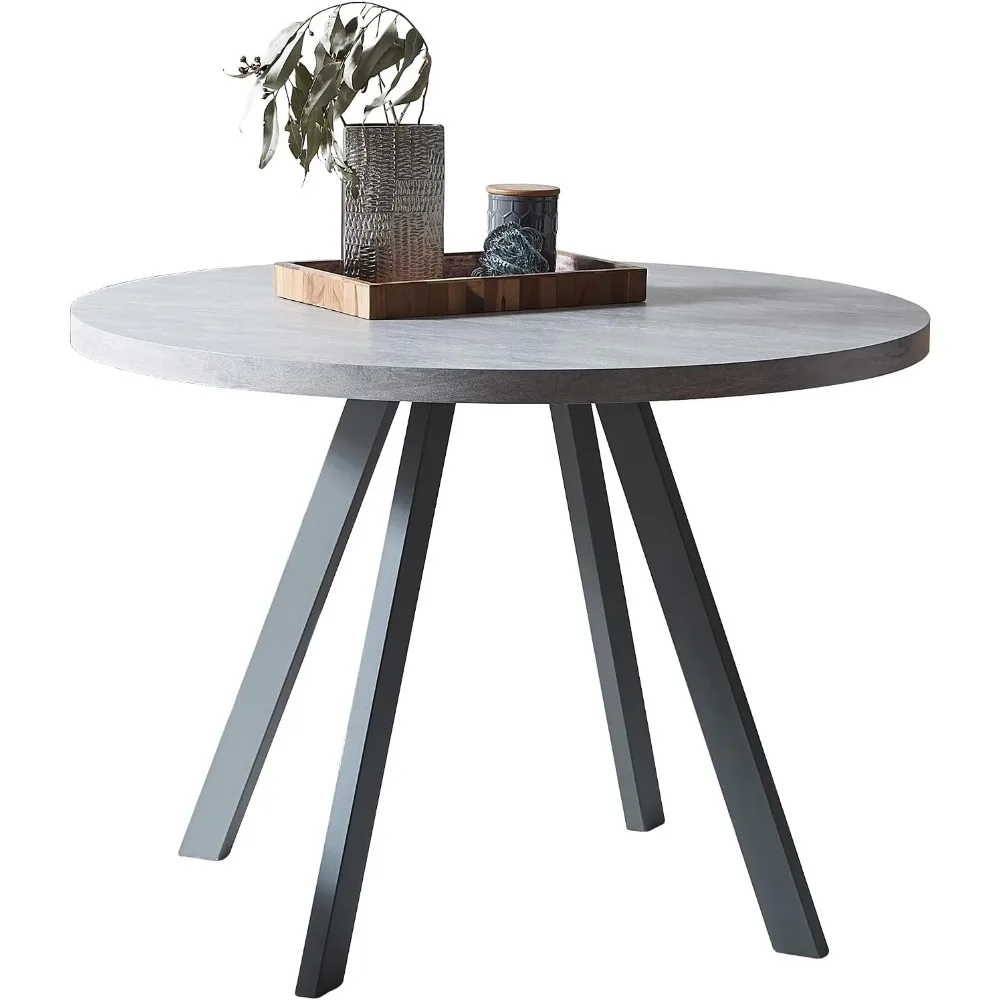
Sculptural Forms: Artistic Expression
Some classic teak coffee tables elevate leg design to sculptural art through:
– Organically shaped solid supports that appear carved from a single piece
– Dramatically curved elements that create visual tension
– Asymmetrical designs that challenge traditional notions of balance
– Complex forms that blur the distinction between leg and frame
These artistic supports often become the defining feature of the table, showcasing the designer’s creativity and the craftsman’s skill.
Sled Bases: Continuous Flow
Sled-based teak coffee tables feature supports formed from continuous pieces of wood that:
– Create a visual sense of fluid movement
– Distribute weight more broadly across the floor
– Often incorporate storage elements within their structure
– Emphasize the horizontal plane with strong linear elements
Floating Designs: Visual Lightness
Some of the most sophisticated classic designs create a floating effect through:
– Recessed legs that visually disappear beneath the tabletop
– Cantilever designs that challenge perceptions of balance
– Minimal contact points with the floor
– Strategic use of negative space to create visual lightness
These support systems do more than hold up a tabletop—they communicate design philosophy through form. The engineering considerations are carefully disguised behind seemingly simple shapes, demonstrating the mid-century principle that complex problems should be solved with elegant simplicity.
Surface Details: The Art of the Tabletop
The tabletop of a classic teak coffee table provides its most visible and tactile surface, offering designers a canvas to showcase both the natural beauty of the wood and their attention to fine details.
Edge Treatments: Defining the Perimeter
The edge profile of a teak tabletop contributes significantly to its visual weight and character:
- Beveled edges: Create a refined transition from top to side, catching light at a subtle angle
- Straight edges: Offer crisp, architectural precision that emphasizes clean lines
- Rounded edges: Provide a softer, more organic feel that’s both visually pleasing and practical
- Sculpted edges: Feature undulating curves or tapered thickness that create a sense of lightness
The thickness of classic teak tabletops typically ranges from 0.75 to 2 inches (19-50mm), with thinner profiles creating a more delicate appearance and thicker ones conveying substantial presence.
Grain Patterns: Nature’s Artwork
In classic teak furniture, the wood grain becomes an integral design element:
- Boards are carefully selected and arranged to showcase attractive grain patterns
- Quarter-sawn teak may be used to display striking linear grain with minimal expansion
- Bookmatched veneers create mirror-image patterns that demonstrate precision craftsmanship
- The direction of grain often follows the longest dimension to visually elongate the piece
Recognizing the natural characteristics of quality teak coffee tables helps discerning buyers appreciate the thoughtful material selection that goes into authentic pieces.
Surface Finishes: Protecting Beauty
The finish applied to teak tabletops balances protection with natural beauty:
- Traditional oil finishes penetrate the wood, enhancing grain while allowing the surface to breathe
- Matte lacquer provides more protection while maintaining a natural appearance
- Hand-rubbed finishes create a subtle luster that deepens over time
- Some classic pieces intentionally show the craftsman’s hand through slight variations in the surface
Special Features: Distinctive Details
Many classic teak coffee tables incorporate unique surface elements:
- Raised edges that contain spills and create visual framing
- Integrated handles carved into the tabletop edges
- Inlaid materials like ceramic tiles, stone, or contrasting woods
- Surface divisions that create visual interest through geometric patterns
These thoughtful surface details reflect the care and consideration that designers put into creating pieces meant to be both used and admired daily. The natural beauty of teak grain, with its warm golden tones and varied patterns, becomes a defining feature that only improves with age as the wood develops its distinctive patina.
Craftsmanship Hallmarks: Joinery and Construction Details
The structural integrity and visual refinement of classic teak coffee tables rely on exceptional joinery—the methods used to connect different parts. These construction techniques reveal the quality of craftsmanship and contribute significantly to both durability and aesthetic appeal.
Mortise and Tenon Joints
Perhaps the most fundamental joinery technique in classic teak furniture:
– Creates exceptionally strong connections between parts
– Features a projecting tenon that fits precisely into a corresponding mortise (cavity)
– Often visible as a design feature, especially where legs meet aprons or stretchers
– May be secured with wooden pegs rather than hidden hardware
Dovetail Connections
The hallmark of quality drawer construction in teak coffee tables:
– Interlocking wedge-shaped “tails” and “pins” create joints that resist pulling apart
– Visible on drawer corners as distinctive triangular patterns
– Demonstrates precision handcraft when tightly fitted
– Becomes stronger, not weaker, with use over time
Finger Joints
Used for joining boards end-to-end or at corners:
– Creates multiple interlocking “fingers” for maximum gluing surface
– Distributes stress across a broader area than simple butt joints
– Often visible as decorative elements on drawer fronts or table edges
– Demonstrates precision machining or handcraft
Mitered Corners
Creates seamless-looking transitions at corners:
– Joins pieces at 45-degree angles to hide end grain
– Often reinforced with hidden splines for strength
– Creates clean, uninterrupted lines around edges
– Requires exceptional precision to execute properly
The philosophy of honest construction is evident in how many mid-century modern solid wood coffee tables display their joinery proudly rather than concealing it. This transparent approach to craftsmanship reveals the structural logic of the piece while creating visual interest through the joints themselves.
Mid-Century Modern Solid Wood Coffee Tables, Mid-Century Modern Teak Coffee Tables
$879.95 Select options This product has multiple variants. The options may be chosen on the product pageMid-Century Modern Danish Coffee Tables, Mid-Century Modern Oval Coffee Tables, Mid-Century Modern Solid Wood Coffee Tables
$390.05 Select options This product has multiple variants. The options may be chosen on the product pageMid-Century Modern Glass Top Coffee Tables, Mid-Century Modern Vintage Coffee Tables, Mid-Century Modern Vintage Side & End Tables
$725.36 Select options This product has multiple variants. The options may be chosen on the product pageMid-Century Modern Large Coffee Tables, Mid-Century Modern Rectangular Coffee Tables
$603.26 Select options This product has multiple variants. The options may be chosen on the product pageMid-Century Modern Marble Top Coffee Tables, Mid-Century Modern Rectangular Coffee Tables, Mid-Century Modern White Coffee Tables
Price range: $163.28 through $189.22 Select options This product has multiple variants. The options may be chosen on the product pageMid-Century Modern Nesting Coffee Tables, Mid-Century Modern Nesting Table Sets
$361.45 Select options This product has multiple variants. The options may be chosen on the product page
Classic teak construction typically minimizes the use of metal hardware, relying instead on the strength of properly executed wood joints. When hardware is used, it’s often thoughtfully designed and may feature quality materials like brass or steel with clean, minimal lines that complement the wood.
The tight-fitting joints, precise angles, and careful alignment seen in quality teak coffee tables aren’t just about aesthetics—they ensure the piece will remain sturdy and beautiful for generations, embodying the mid-century ideal of enduring design.
Functional Elements: Storage and Versatility Features
Classic teak coffee tables brilliantly balance form with function, incorporating practical elements that enhance usability without compromising aesthetic purity. These thoughtful features demonstrate the mid-century commitment to creating furniture that works as beautifully as it looks.
Integrated Storage Solutions
Many classic teak coffee tables incorporate clever storage options:
- Hidden drawers: Often featuring flush fronts with minimal or recessed pulls
- Magazine shelves: Open storage beneath the tabletop, typically featuring slatted construction
- Compartments: Divided sections for organizing smaller items
- Floating shelves: Secondary surfaces that appear to hover beneath the main tabletop
These storage elements follow the principle that everything should have a place—a core tenet of mid-century design philosophy that remains relevant in today’s homes.
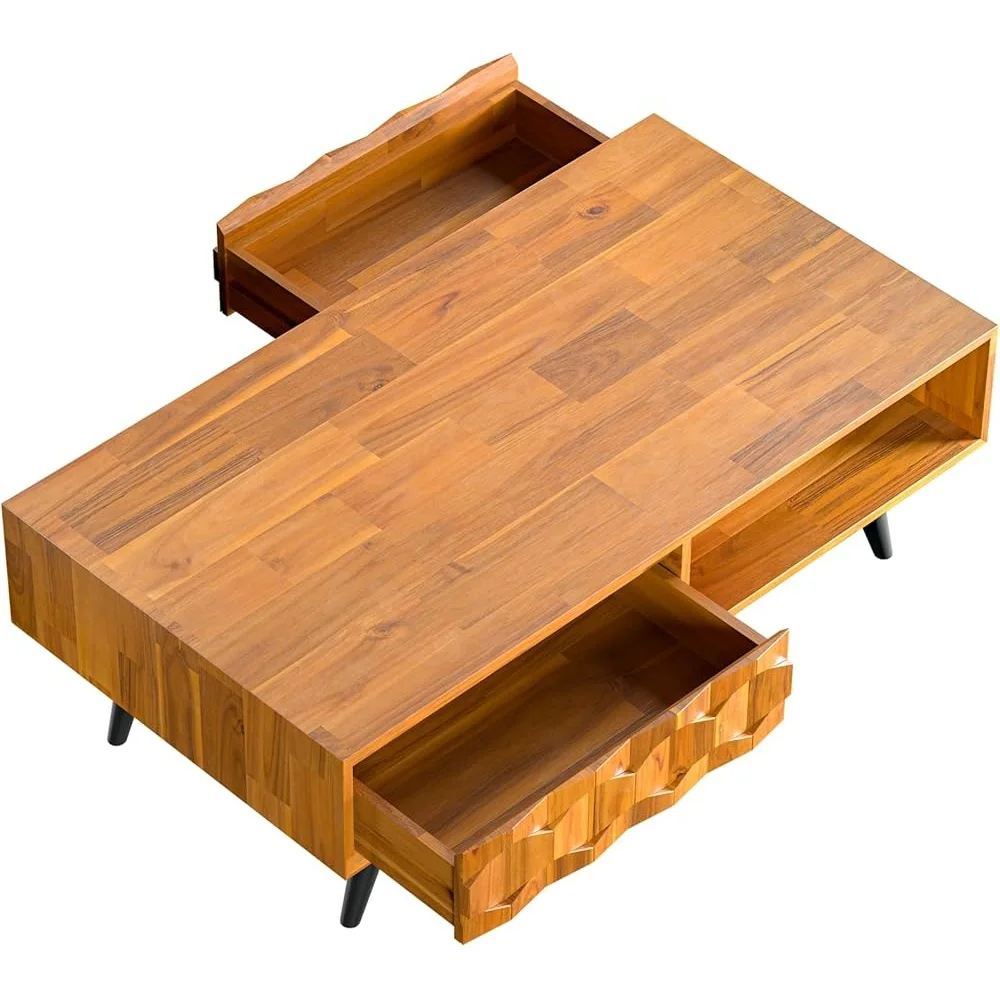
Multi-Level Designs
Some classic teak tables feature varied surface heights that:
– Create visual interest through dimensional play
– Provide separate zones for different activities or display purposes
– Allow for versatility in arrangement and use
– Maximize functionality within a compact footprint
Transformable Elements
The most innovative classic designs incorporate elements that adapt to different needs:
- Extending surfaces: Leaves or panels that expand the usable area
- Adjustable heights: Mechanisms that raise or lower the tabletop for different uses
- Nesting coffee tables: Smaller tables that tuck beneath larger ones when not needed
- Modular components: Sections that can be reconfigured or used separately
These versatile features reflect a understanding that home spaces need to serve multiple functions—an insight that was revolutionary when these pieces were designed and remains relevant today.
What makes these functional elements special in classic teak coffee tables is how seamlessly they’re integrated into the overall design. Storage doesn’t appear as an afterthought but as an integral part of the table’s identity. The operating parts—drawer slides, hinges, and mechanisms—are engineered with the same attention to detail as the visible elements, ensuring smooth function that enhances the user experience.
Distinguishing Authentic Classic Teak: Material Quality and Characteristics
Identifying genuine teak and assessing its quality is essential for collectors and buyers who value authentic classic pieces. The material itself is a significant part of what makes these coffee tables special, with characteristics that distinguish true teak from imitations.
Visual Identification
Genuine teak displays distinctive visual traits:
– Color range: Fresh teak varies from golden honey to medium brown with darker mineral streaks
– Grain patterns: Straight to slightly wavy grain with occasional irregular patterns
– Surface appearance: Slightly oily or waxy sheen when unfinished
– Aging characteristics: Develops a silvery-gray patina over time when exposed to air
Understanding the visual language of different styles, including black mid-century modern coffee table styles, helps provide context for recognizing authentic teak pieces within the broader spectrum of classic designs.
Physical Properties
Teak can be identified through its physical characteristics:
– Weight: Genuine teak is dense and heavy (approximately 40-45 pounds per cubic foot or 640-720 kg/m³)
– Texture: Smooth with a slightly uneven feel due to alternating hard and soft grain
– Scent: A distinctive leather-like or slightly sweet woody smell, especially when freshly cut
– Hardness: Firm but can be dented with significant force
Material Grades
Not all teak is created equal:
– Old-growth or vintage teak: Densest grain, highest oil content, often reclaimed from older structures
– Plantation-grown teak: More uniform coloring, slightly lighter, still excellent quality when mature
– Burmese teak: Traditionally considered the highest quality due to growing conditions
– Sapwood vs. heartwood: Quality pieces use primarily the more durable heartwood
Authenticating Solid vs. Veneer Construction
Classic teak coffee tables may be solid wood or use quality veneers:
– Solid teak edges will show consistent grain going around corners
– Veneered pieces should still use real teak veneer over quality substrate
– End grain visible on edges or underside helps identify solid construction
– Weight provides clues—solid teak pieces are noticeably heavy
Sustainable Sourcing
Today’s market values responsibly sourced teak:
– Look for FSC certification for new pieces
– Vintage and antique pieces represent sustainable choices through reuse
– Reclaimed teak offers character while avoiding new harvesting
The ability to recognize these quality markers helps distinguish authentic classic pieces from modern reproductions that might mimic the style but lack the material integrity of the originals. True teak coffee tables aren’t just designed to look good when new—they’re created from materials chosen specifically for how they perform and improve over decades of use.
Classic vs. Contemporary: How to Recognize Timeless Design
Understanding the distinction between truly classic teak coffee tables and more contemporary interpretations helps collectors and design enthusiasts make informed choices. While modern pieces may borrow aesthetic elements from classic designs, certain characteristics define authentic timeless appeal.
Classic Hallmarks vs. Modern Adaptations
| Classic Design Elements | Contemporary Interpretations |
|---|---|
| Balanced proportions based on human scale | Sometimes exaggerated proportions for dramatic effect |
| Honest construction with visible joinery | May hide construction details behind cleaner lines |
| Natural finish highlighting wood grain | Often darker stains or painted finishes |
| Minimal hardware with integrated pulls | More prominent or decorative hardware elements |
| Gentle organic curves or clean straight lines | May feature more dramatic or asymmetrical forms |
The Elements of Timelessness
Truly classic teak coffee tables share certain qualities that transcend era-specific trends:
– Clean lines that avoid decorative excess without feeling stark or severe
– Organic inspiration that references natural forms without literal representation
– Functional elements that enhance usability without compromising beauty
– Scale and proportion that feel “right” in relation to human dimensions
– Material honesty that celebrates the inherent qualities of teak
These principles create pieces that feel both familiar and fresh regardless of when they were made, avoiding the dated quality that affects more trendy designs.
Vintage Authenticity vs. Reproduction
Identifying design eras in vintage tables requires attention to specific details:
- Original classic pieces often show age-appropriate patina and wear patterns
- Construction techniques reflect the technology available in their era
- Hardware, if present, corresponds to period-specific styles
- Proportions and dimensions follow standards common to their time
- Designer pieces may have maker’s marks or labels
Quality reproductions have their place, but they typically differ from originals in subtle ways that trained eyes can detect in joinery details, wood selection, or finishing techniques.
Finding Balance
The most successful contemporary teak coffee tables acknowledge their classic inspirations while making thoughtful updates for modern living. They understand that what makes classic design enduring isn’t slavish adherence to specific forms, but rather the underlying principles of quality materials, thoughtful construction, and balanced proportions that guided the original designers.
Preserving Beauty: Essential Care for Classic Teak Tables
Proper maintenance ensures your classic teak coffee table remains beautiful for generations, preserving both its appearance and value. Caring for teak requires understanding its unique properties and following practices that work with—rather than against—the natural characteristics of the wood.
Routine Cleaning
For day-to-day care:
– Dust regularly with a soft, slightly damp cloth
– Wipe in the direction of the wood grain
– Clean spills promptly to prevent staining
– Use only mild soap and water for deeper cleaning
– Avoid commercial furniture polishes containing silicones or waxes
Addressing Stains and Marks
For common issues:
– Water rings: Apply a mixture of equal parts white vinegar and olive oil
– Ink marks: Dab with denatured alcohol on a cotton swab
– Food stains: Create a paste with baking soda and water, apply gently
– Scratches: Rub with the meat of a walnut or use a touch-up marker matching the wood tone
The Oiling Question
One of the most debated topics in teak care:
– Traditional approach: Apply teak oil every 3-6 months to maintain color
– Natural approach: Allow the wood to develop its silvery patina naturally
– Middle ground: Occasional oiling (once yearly) to refresh appearance while allowing character to develop
If choosing to oil, use only products specifically formulated for teak furniture, and apply sparingly with a lint-free cloth.
Environmental Considerations
Protect your table from environmental stresses:
– Maintain consistent humidity levels (40-60%) when possible
– Use coasters under wet glasses to prevent water rings
– Place the table away from direct sunlight to prevent uneven fading
– Use protective pads under hot items to prevent heat marks
– Consider seasonal wood movement when placing items on the table
Restoration Techniques
For older pieces needing renewal:
– Clean thoroughly with a mild soap solution
– Sand very lightly with fine-grit sandpaper (220+) if necessary
– Apply teak oil or sealer according to the finish you prefer
– Consider professional restoration for valuable or significantly damaged pieces
The beauty of classic teak coffee tables often lies in their patina—the character developed through years of use. Rather than trying to maintain a “like new” appearance, many collectors value the subtle changes that occur as the wood matures and tells the story of its life in your home.
The Investment Value: Why Classic Teak Coffee Tables Endure
Unlike mass-produced furniture that quickly loses value, classic teak coffee tables often represent genuine investments that maintain or appreciate in worth over time. This enduring value stems from multiple factors that distinguish quality pieces in both the marketplace and home environments.
Financial Considerations
Classic teak coffee tables offer investment potential through:
– Increasing scarcity as original materials become harder to source
– Growing appreciation for mid-century design among collectors
– Quality construction that ensures longevity beyond trends
– Proven design that maintains relevance across changing interior styles
For many collectors, mid-century modern vintage coffee tables represent not just furniture but artifacts of design history with established provenance and collectible value.
Sustainability Value
Investing in classic pieces aligns with environmental consciousness:
– Reducing consumption through furniture that lasts generations
– Choosing solid wood pieces that can be repaired rather than replaced
– Appreciating natural materials that age beautifully rather than deteriorate
– Supporting design principles that value longevity over planned obsolescence
Versatility Across Interiors
Classic teak coffee tables maintain relevance because:
– Their clean lines complement diverse interior styles from traditional to contemporary
– Natural wood tones work with evolving color trends
– Their proportions follow human-centered design principles that remain consistent
– Their fundamental utility addresses needs that don’t change with fashion
Emotional Investment
Beyond financial considerations, these pieces offer:
– Connection to design history and cultural moments
– Daily interaction with authentic craftsmanship
– The development of personal history as the piece ages with your family
– The satisfaction of owning objects that gain character rather than decline with age
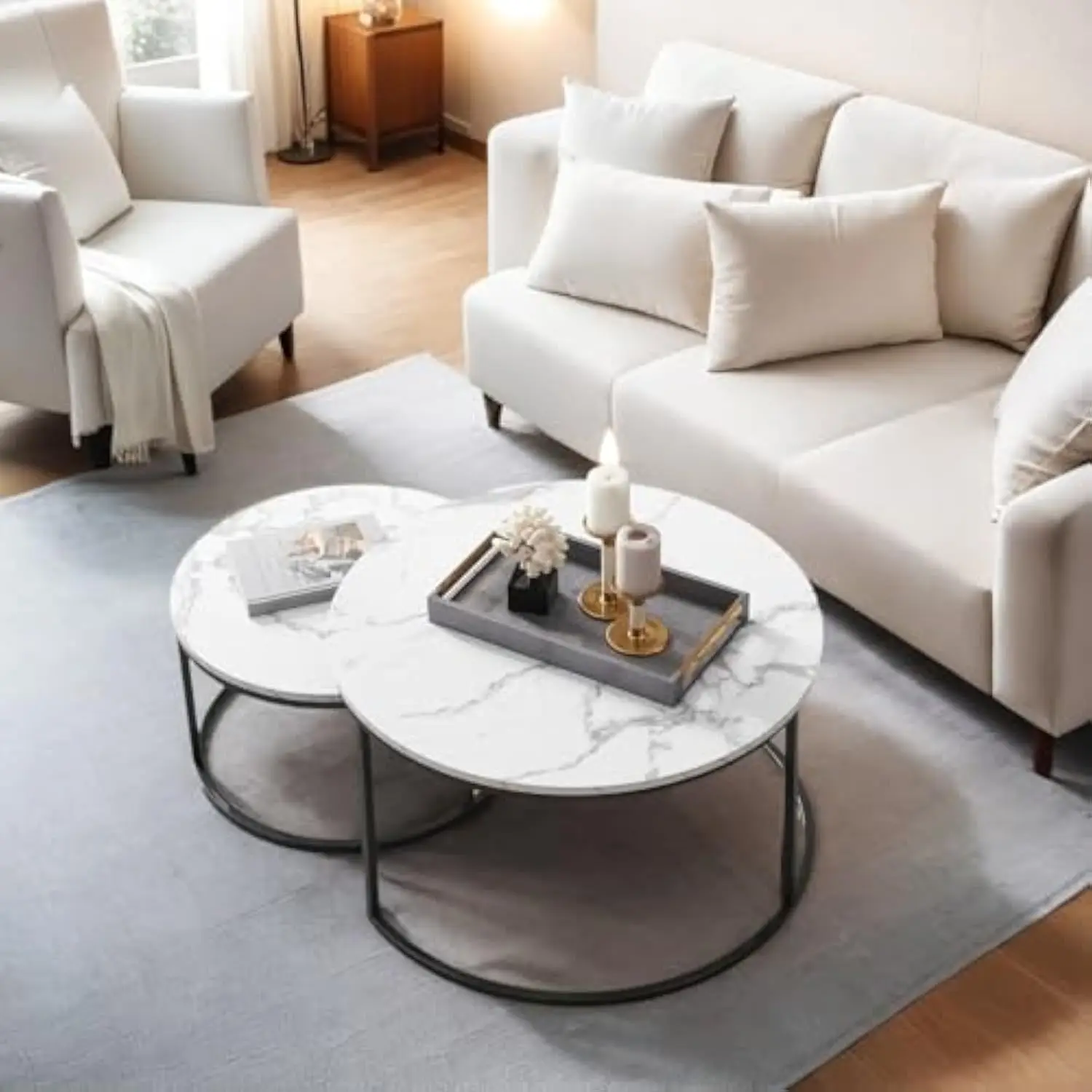
The patina that develops on teak over decades of use isn’t seen as deterioration but as enhancement—a visual record of the piece’s story in your home. This perspective represents a fundamental shift away from disposable furniture culture toward an appreciation for objects that grow more beautiful and meaningful with time.
How Do Classic Teak Coffee Tables Compare to Other Wood Tables?
While teak remains the premier choice for many classic coffee table designs, understanding how it compares to other woods helps explain its enduring popularity and distinctive characteristics within the spectrum of quality furniture materials.
Comparative Wood Properties
| Wood Type | Durability | Maintenance | Aesthetic Quality | Value Retention |
|---|---|---|---|---|
| Teak | Exceptional resistance to moisture, insects | Minimal; natural oils provide protection | Warm golden tones aging to silver-gray | Excellent; often appreciates |
| Walnut | Very good; moderately hard | Periodic oiling recommended | Rich chocolate browns with purple undertones | Very good for quality pieces |
| Oak | Excellent hardness; prone to water rings | Regular maintenance needed | Light to medium brown with prominent grain | Good for solid construction |
| Mahogany | Good; sensitive to humidity changes | Requires consistent care | Reddish-brown with straight grain | Good for authentic pieces |
| Rosewood | Excellent; contains natural oils | Occasional oiling beneficial | Dark with distinctive figuring | Excellent; increasingly rare |
For those exploring alternatives to teak, our collection of mid-century modern walnut coffee tables showcases another exceptional wood with its own distinctive character and design heritage.
What Makes Teak Uniquely Suited to Coffee Tables
Teak stands apart from other furniture woods in several key ways:
– Natural oils that resist coffee spills, water rings, and other common hazards
– Dimensional stability that prevents warping even with humidity changes
– Balanced hardness that resists damage without being difficult to work
– Visual warmth that complements diverse interior color schemes
Sustainability Considerations
The environmental impact varies across wood types:
– Teak: Concerns about old-growth forests have led to plantation growing
– Walnut: Domestically grown options offer more sustainable alternatives
– Oak: Widely available from managed forests in many regions
– Exotic woods: Often face stricter import regulations due to conservation concerns
The increasing focus on responsible sourcing has made reclaimed and vintage teak furniture even more valuable, as it offers the material’s benefits without environmental concerns about new harvesting.
Design Feature Variations
Different woods lend themselves to different design approaches:
– Teak’s straight grain allows for clean, minimal lines
– Walnut’s rich color creates dramatic silhouettes
– Oak’s strength permits thinner structural elements
– Exotic woods often become focal points through distinctive figuring
Understanding these material differences explains why certain classic designs are associated with specific woods—the designers chose materials that perfectly suited their vision for each piece.
Can Classic Design Elements Work in Modern Interiors?
One of the most remarkable aspects of classic teak coffee tables is their extraordinary versatility across interior styles. Rather than feeling dated or out of place, these pieces often become the anchoring elements that bring cohesion to contemporary spaces.
The Versatility of Classic Teak
Classic teak coffee tables integrate seamlessly with modern interiors because:
– Their clean lines complement contemporary minimalism
– Natural wood tones add warmth to modern spaces that might otherwise feel cold
– Their timeless proportions provide visual stability amid changing trends
– Their functionality addresses needs that remain consistent across eras
Understanding how various styles go well with mid-century modern pieces helps homeowners create cohesive interiors that respect design history without feeling like museums.
Creating Balance Through Contrast
Some of the most successful interior designs deliberately pair classic teak with contrasting elements:
– Classic teak tables with contemporary upholstered seating
– Warm wood tones against cool concrete or metal surfaces
– Vintage pieces alongside current technology
– Organic wood forms balanced with geometric modern art
This juxtaposition creates visual tension that brings energy to living spaces while highlighting the enduring design qualities of each element.
Letting Classic Pieces Become Focal Points
In modern interiors, a classic teak coffee table can serve as:
– A central design statement around which other elements are arranged
– A grounding force that adds history and character to newer spaces
– A connection to design heritage that gives depth to contemporary rooms
– A conversation piece that tells a story beyond mere function
Practical Integration Tips
To successfully incorporate classic teak coffee tables into modern spaces:
– Allow adequate space around the piece to appreciate its proportions
– Choose accessories that bridge vintage and contemporary aesthetics
– Consider the scale relationship between the table and surrounding furniture
– Use lighting to highlight the wood’s natural beauty and craftsmanship details
The most successful interiors don’t force an artificial separation between “vintage” and “contemporary” elements but instead create thoughtful dialogues between pieces from different eras that share fundamental design values.
Is a Classic Teak Coffee Table Right for Your Space?
Before investing in a classic teak coffee table, consider several practical factors to ensure it will serve your needs while complementing your living environment. This thoughtful approach helps match your specific circumstances with the right piece.
Space and Proportion Considerations
Ask yourself:
– What size table will fit comfortably in your available space?
– How much clearance do you need around the table for comfortable movement?
– What height works best with your seating (ideally 1-2 inches lower than cushion height)?
– Will the visual weight of teak complement or overwhelm your space?
As a general rule, allow at least 18 inches (45cm) between the coffee table and seating, with enough room to walk around the arrangement comfortably.
Functional Requirements
Consider how you’ll actually use the table:
– Do you need storage for remote controls, magazines, or games?
– Will the table primarily serve decorative purposes or regular daily use?
– Do you entertain frequently, requiring space for drinks and snacks?
– Do you need a surface for working or dining occasionally?
Your honest assessment of these needs helps determine whether a purely sculptural piece or a more functional design with storage would better serve your lifestyle.
Lifestyle Factors
Be realistic about your living situation:
– Households with young children might prefer rounded corners and durable finishes
– Homes with pets should consider scratch resistance and stability
– Frequent entertainers might prioritize larger surfaces or stain resistance
– Those who move frequently should consider weight and disassembly options
Long-Term Investment Thinking
A quality classic teak coffee table represents a significant purchase, so consider:
– Do you appreciate how teak ages and develops character over time?
– Are you comfortable with the maintenance requirements?
– Does the design have staying power as your taste evolves?
– Will this piece move with you through different homes and life stages?
The best choices come from balancing immediate practical needs with long-term appreciation. A classic teak coffee table should solve today’s functional challenges while providing lasting beauty and value that grows over time—exactly the principle that guided the original designers of these enduring pieces.
For many discerning homeowners, the investment in authentic quality offered by Hearth Forms pieces represents not just a furniture purchase but an introduction to a more thoughtful way of living with objects that genuinely improve with time.

